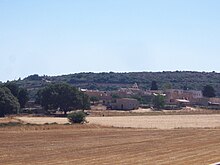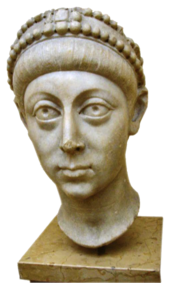Arkadi monastery
The Arkadi Monastery (in Greek: / Μονή Αρκαδίου) is an Eastern Orthodox monastery, situated on a fertile plateau 23 km (14 mi) to the southeast of Rethymnon on the island of Crete in Greece.
The current catholicon (church) dates back to the 16th century and is marked by the influence of the Renaissance. This influence is visible in the architecture, which mixes both Roman and baroque elements. As early as the 16th century, the monastery was a place for science and art and had a school and a rich library. Situated on a plateau, the monastery is well fortified, being surrounded by a thick and high wall.
The monastery played an active role in the Cretan resistance of Ottoman rule during the Cretan revolt of 1866. 943 Greeks, mostly women and children,[1] sought refuge in the monastery. After three days of battle and under orders from the hegumen (abbot) of the monastery, the Cretans blew up barrels of gunpowder, choosing to sacrifice themselves rather than surrender.
The monastery became a national sanctuary in honor of the Cretan resistance. 8 November is a day of commemorative parties in Arkadi and Rethymno. The explosion did not end the Cretan insurrection, but it attracted the attention of the rest of the world.

Arkadi Gorge
The Arkadi Monastery is located in the Rethymno regional unit, 25 km southeast of Rethymno. The Monastery is situated on a rectangular plateau on the northwest side of Mount Ida (Crete), at an altitude of 500 m.[2] The Arkadian region is fertile and has vineyards, olive groves and pine, oak and Cyprus forests. The plateau on which the monastery rests is surrounded by hills. The west side of the plateau stops abruptly and falls off into gorges. The gorges start at Tabakaria and lead to Stavromenos, to the east of Rethymno. The Arkadian gorges have a rich diversity of plants and native wildflowers.[3]

The Arkadian Plateau
The area the monastery is located in first developed in antiquity. The presence of Mount Ida (Crete), which is a sacred mountain because it was legendarily the childhood home of Zeus, made the area attractive to early settlers. Five km to the northeast, the city of Eleftherna had its cultural peak in the time of Homer and in classical antiquity, but its influence was also felt in the early Christian and Byzantine periods.
The closest village to the monastery is Amnatos, located three km to the north. The villages that surround Arkadi are rich in Byzantine relics that prove the early wealth of the region. The Moni Arseniou monastery, which is several km north of Arkadi, was also an example of the grand Cretan monasteries.
Arkadi Monastery is in the shape of a nearly rectangular parallelogram. The interior resembles a fortress and is 78.5 metres long on the north wall, 73.5 metres on the south wall, 71.8 metres on the east wall and 67 metres on the west wall. The total area of the monastery is 5200 m².[4]

The Emperor Arcadius, who founded the monastery according to tradition.
The exact date of the founding of the monastery is not precisely known. According to tradition, the foundation of the monastery is sometimes attributed to the Byzantine emperor Heraclius and sometimes to the emperor Arcadius in the 5th century. And, according to the second version, the monastery took its name from the name of the emperor. However, in Crete, it is common for monasteries to be named after the monk that founded the building, which lends support to the theory that Arkadi may have been founded by a monk named Arkadios. Other such monasteries are Vrontisiou, Arsiniou and Aretiou.
According to Joseph Pitton de Tournefort, the monastery was built on the site of an ancient city, Arcadia. Legend tells that after the destruction of Arcadia, all the springs and fountains stopped flowing until a new city was built.[5][Note 1] However, in 1837, Robert Pashley found evidence to suggest that it was impossible for the monastery to have been built on the ruins of another city,[6] so this idea has lost credence.
In 1951, the professor K. Kalokyris published an inscription dating to the 14th century and verified the hypothesis that a monastery was dedicated to Saint Constantine in this period. The inscription was located on the pediment of a church that predates the current one, over the entrance door. It read:
"The church carrying the name of Arkadi is consecrated to Saint Constantine."[Note 2]
Restorations
Towards the end of the 16th century, the monastery was subject to restorations and transformations largely headed by Klimis and Vissarion Chortatzis, without a doubt from the family of Hortatzis of Rethymno (a name associated with the Cretan Renaissance) and Georgios Chortatzis, the author of Erofili. Klimis Hortatzis was the hegumen of the abbey and in 1573, he made the monastery cenobitic.
He oversaw the building of the church, which took twenty-five years and was believed to have begun in 1562.[7] In 1586, the façade of the building was built,[8] as were the two naves. An inscription at the base of the clock also dates it back to 1587. This inscription is as following:
« ΑΦ ΚΛΜΧΤΖ ΠΖ »
or : « 15 Klimis Chortatzis 87 »
Klimis Chortatzis likely died soon after the completion and was not able to attend the inauguration of the new church, which was sometime between 1590 and 1596. This is known thanks to a letter of the Patriarch of Alexandria, Mélétios Pigas, in which he wrote that the inauguration ceremony was entrusted to Klimis's successor, the hegumen Mitrofanis Tsyrigos. Although this letter wasn't dated, one can place it between 1590, when Mélétios Pigas was ordained the Patriarch, and 1596, when the hegumen Nicéphore succeeded Tsygiros.
During the period of the first three hegumens, and up to the beginning of the 17th century, the Arkadi Monastery continued to boom, economically and culturally. The monastery became a great centre for the copying of manuscripts, and although the majority were lost during the destruction of the building by the Ottomans in 1866, some survive in foreign libraries. The monastery grew, with the construction of a stables in 1610 and a refectory in 1670.
From Wikipedia, the free encyclopedia

